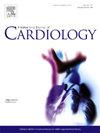Relation between previously implanted coronary stents and vasospasm: Patient- and vessel-level analysis
IF 3.2
2区 医学
Q2 CARDIAC & CARDIOVASCULAR SYSTEMS
引用次数: 0
Abstract
Background
Catheter-based coronary interventions, particularly those with stent implantation, are associated with arterial wall injury, leading to endothelial dysfunction and vasospasm. However, the impact of previously implanted coronary stents on vasospasm during acetylcholine (ACh) provocation testing remains uncertain.
Methods
From May 2012 to October 2023, a total of 1039 patients underwent intracoronary ACh provocation tests for the diagnosis of vasospastic angina. Patients and coronary vessels were divided into two groups according to the presence of previously implanted coronary stents. Angiographic coronary vasospasm was defined as total or subtotal occlusion induced by ACh injection at the vessel level, and positive diagnosis of ACh testing was defined as angiographic coronary vasospasm accompanied by chest symptoms and/or ischemic electrocardiographic changes at the patient level.
Results
Of the 1039 patients, 175 (16.8 %) had previously implanted coronary stents. The incidence of positive ACh provocation test was significantly higher in patients with previous coronary stents than in those without (60.6 % vs. 52.0 %, P = 0.04). At the vessel-level analysis, intracoronary ACh was administered in the 175 patients with a history of coronary stenting, with coronary arteries with previously implanted coronary stents (n = 236) and no stents (n = 254). ACh-induced angiographic vasospasm was more frequently observed in vessels with coronary stents than in those without (50.0 % vs. 33.3 %, P < 0.001). No significant interactions between bare metal and drug-eluting stents were found in the rate of ACh-induced vasospasm.
Conclusions
Previously implanted stents were associated with coronary vasoreactivity during intracoronary ACh provocation testing at the patient and vessel levels.
背景基于导管的冠状动脉介入治疗,尤其是植入支架的介入治疗,与动脉壁损伤有关,会导致内皮功能障碍和血管痉挛。然而,先前植入的冠状动脉支架对乙酰胆碱(ACh)激发试验中血管痉挛的影响仍不确定。方法从 2012 年 5 月到 2023 年 10 月,共有 1039 名患者接受了冠状动脉内 ACh 激发试验,以诊断血管痉挛性心绞痛。根据先前是否植入冠状动脉支架将患者和冠状动脉血管分为两组。血管造影冠状动脉血管痉挛的定义是血管注射 ACh 引起的完全或次完全闭塞,ACh 试验阳性诊断的定义是血管造影冠状动脉血管痉挛伴有胸部症状和/或患者缺血性心电图改变。曾植入冠状动脉支架的患者 ACh 激发试验阳性率明显高于未植入支架的患者(60.6% 对 52.0%,P = 0.04)。在血管层面的分析中,对175名有冠状动脉支架植入史的患者进行了冠状动脉内ACh试验,这些患者的冠状动脉曾植入冠状动脉支架(236人)和未植入支架(254人)。有冠状动脉支架的血管比没有支架的血管更常出现 ACh 引起的血管痉挛(50.0% 对 33.3%,P <0.001)。结论在患者和血管水平上,先前植入的支架与冠状动脉内 ACh 激发试验中的冠状动脉血管反应相关。
本文章由计算机程序翻译,如有差异,请以英文原文为准。
求助全文
约1分钟内获得全文
求助全文
来源期刊

International journal of cardiology
医学-心血管系统
CiteScore
6.80
自引率
5.70%
发文量
758
审稿时长
44 days
期刊介绍:
The International Journal of Cardiology is devoted to cardiology in the broadest sense. Both basic research and clinical papers can be submitted. The journal serves the interest of both practicing clinicians and researchers.
In addition to original papers, we are launching a range of new manuscript types, including Consensus and Position Papers, Systematic Reviews, Meta-analyses, and Short communications. Case reports are no longer acceptable. Controversial techniques, issues on health policy and social medicine are discussed and serve as useful tools for encouraging debate.
 求助内容:
求助内容: 应助结果提醒方式:
应助结果提醒方式:


